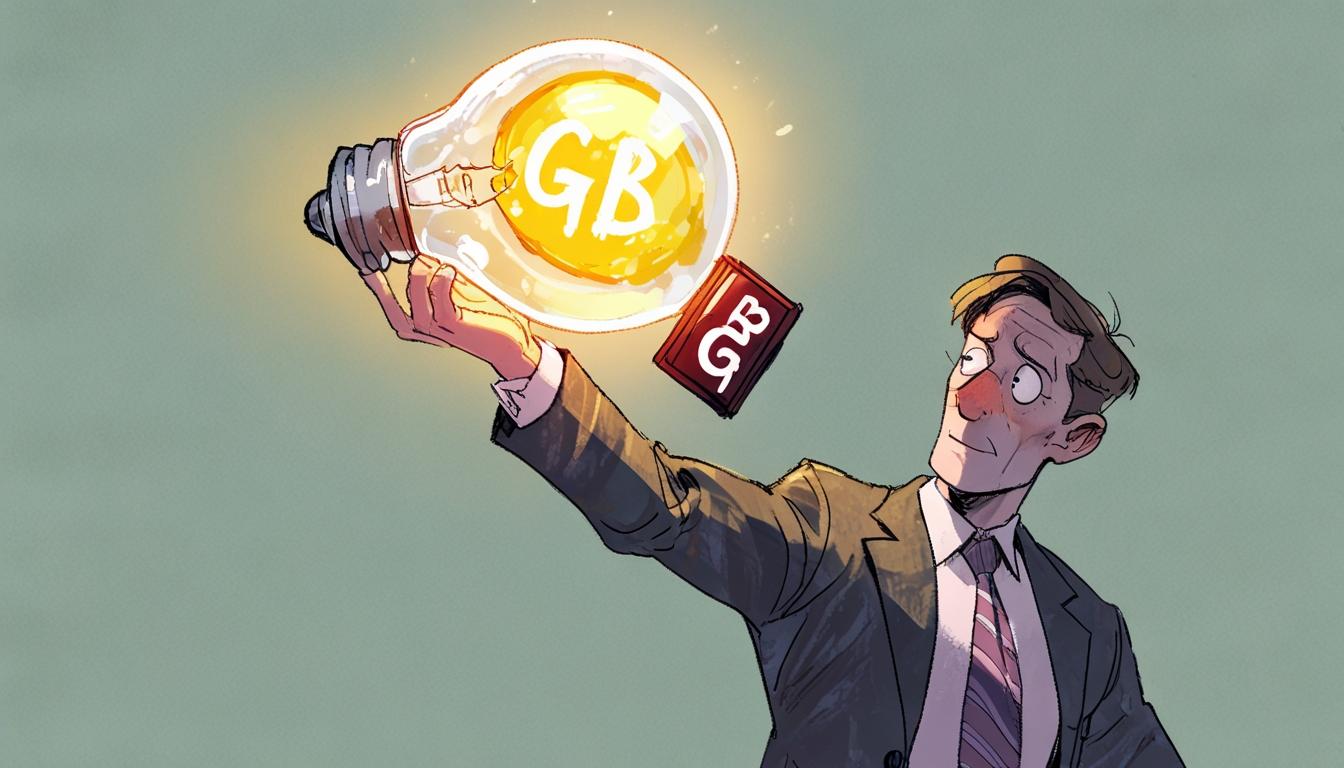Labour’s Great British Energy faces intense scrutiny after spending over £10,000 on redesigning a mocked logo, revealing broader doubts about the initiative’s funding, management and energy policy credibility amid Treasury funding reviews.
The scrutiny surrounding Great British Energy (GB Energy) has intensified following revelations about significant expenses related to its logo redesign, highlighting potential mismanagement within the initiative spearheaded by Labour. The UK Government reportedly incurred costs exceeding £10,000 to address branding issues after the original logo was ridiculed for its striking resemblance to that of a New York advertising agency.
Kevin Stewart, the SNP MSP for Aberdeen, has been vocal in his criticism, deeming the expenditure “ridiculous” given that it stems from officials’ negligence in verifying the uniqueness of their branding. A Freedom of Information request has unveiled that £10,710, plus VAT, was spent on legal and copyright fees associated with the new logo. This redesign followed the uproar over its initial iteration, which featured a cartoon lightbulb and was sourced from a stock image site for merely £35. The logo not only mirrored the aesthetics of We Think Advertising in the US but was also reminiscent of similar designs from Indian lighting company Chatur Lights.
This incident has drawn sharp rebuke from political opponents, who argue it signifies broader inadequacies in Labour’s strategy for the energy sector. Conservative Party Chairman Richard Holden pointedly questioned the party’s commitment to energy security, suggesting that the logo fiasco merited concern about the authenticity of the entire GB Energy initiative. Such criticisms paint a dire picture of a government struggling to establish credibility in its energy policies, particularly when Labour professes a strong commitment to renewable energy.
The redesign was reportedly necessary to distance the organisation from the initial embarrassment, yet questions linger regarding its need for actual operational substance. Despite the hollow branding exercise, GB Energy has ambitious plans to funnel considerable investments into green energy projects, focusing on wind and solar. The organisation, still without formal employees and operating from shared office space with the Department for Energy Security and Net Zero, is seen by some as lacking a tangible foundation.
An underlying backdrop concerns the future funding for GB Energy, which has been positioned with £8.3 billion allocated over the current parliamentary term. However, recent reports indicate the UK Treasury is contemplating cuts to this funding. This poses significant challenges for Energy Secretary Ed Miliband, as the department reviews its spending priorities. The Institute for Public Policy Research has warned that without full funding, GB Energy may struggle to meet its targets, including supplying 5% of the UK’s electricity by the 2030s—a goal that contributes to Labour’s promise of diminishing household energy costs.
Thus, the controversy over the GB Energy logo serves as a poignant symbol of the greater turbulence within Labour’s renewable energy agenda. While the government insists that it is dedicated to revitalising the UK’s industrial heartlands and achieving energy independence, the series of missteps raises questions about the party’s seriousness in delivering on these commitments. As the initiative faces both scrutiny and scepticism, it remains to be seen whether GB Energy will emerge as a credible force or remain, as critics suggest, merely a façade for government aspirations in renewable energy.
Reference Map
- Paragraph 1: [1]
- Paragraph 2: [1], [2], [3]
- Paragraph 3: [3], [4]
- Paragraph 4: [5], [7]
- Paragraph 5: [6], [4]
- Paragraph 6: [7]
Source: Noah Wire Services
- https://www.pressandjournal.co.uk/fp/politics/6755045/gb-energy-new-logo-cost/ – Please view link – unable to able to access data
- https://www.express.co.uk/news/politics/1905673/Labour-GB-Energy-blunder – Labour’s announcement of Great British Energy (GB Energy) was mocked after it was revealed that the new logo was purchased from a stock image website for £35. The logo, a cartoon lightbulb, was found to be similar to designs used by other companies, including ‘We Think Advertising’ and ‘Chatur Lights’. The incident led to criticism from political opponents, highlighting concerns over the party’s approach to the energy sector.
- https://www.telegraph.co.uk/politics/2024/05/31/labour-great-british-energy-mocked-logo-advertising-agency/ – Labour’s unveiling of the GB Energy logo faced ridicule after it was discovered that the design closely resembled one used by a New York-based advertising agency, ‘We Think Advertising’. The logo, featuring a cartoon lightbulb, was also similar to that of Indian lighting company ‘Chatur Lights’. The design was reportedly available for purchase on the stock image website Dreams Time. Conservative Party Chairman Richard Holden criticized the move, questioning the authenticity of the logo and the party’s commitment to energy security.
- https://newshubgroup.co.uk/news/labour-redesigns-gb-energy-logo-after-being-mocked-for-using-stock-image – In response to criticism over the initial GB Energy logo, which was mocked for using a stock image, Labour redesigned the logo. The new design features a different color and graphic. GB Energy, a government-backed company, aims to invest in renewable energy projects, including wind and solar, and is headquartered in Aberdeen, Scotland. The initiative is part of Labour’s commitment to reducing Britain’s reliance on fossil fuels and lowering household energy bills.
- https://www.theguardian.com/business/2025/mar/07/uk-treasury-plans-funding-cuts-at-gb-energy-in-blow-to-ed-miliband – The UK Treasury is reportedly considering cuts to the funding of GB Energy, the state-owned company established by Labour to promote renewable energy and reduce household bills. The potential reduction in the £8.3 billion funding over the five-year parliament could impact the company’s ability to fulfill its objectives. Energy Secretary Ed Miliband faces challenges as the government reviews its spending priorities, with GB Energy’s future funding under scrutiny.
- https://www.newsminimalist.com/articles/labour-redesigns-gb-energy-logo-after-criticism-36f5beea – Labour faced criticism after the initial GB Energy logo was found to be a stock image. In response, the party redesigned the logo, which now features a different color and design. GB Energy, a government-owned company, aims to invest in renewable energy projects, including wind and solar, and is headquartered in Scotland. The initiative is part of Labour’s commitment to reducing Britain’s reliance on fossil fuels and lowering household energy bills.
- https://www.theguardian.com/business/2025/mar/19/gb-energy-needs-full-83bn-fundingdisappoint-government-told – The Institute for Public Policy Research (IPPR) has warned that GB Energy requires the full £8.3 billion funding to meet its objectives of supplying 5% of the UK’s electricity needs by the 2030s. The think tank’s report suggests that without complete funding, the government risks disappointing voters who expect cheaper energy bills in the next decade. The warning comes amid reports that the Treasury is considering cuts to GB Energy’s budget in the upcoming spending review.
Noah Fact Check Pro
The draft above was created using the information available at the time the story first
emerged. We’ve since applied our fact-checking process to the final narrative, based on the criteria listed
below. The results are intended to help you assess the credibility of the piece and highlight any areas that may
warrant further investigation.
Freshness check
Score:
8
Notes:
The narrative is recent, referencing ongoing political and financial developments. However, the controversy itself might have originated from earlier events, but the article incorporates recent perspectives and financial discussions.
Quotes check
Score:
5
Notes:
The article includes remarks from Kevin Stewart and Richard Holden, but lacks specific dates for these quotes. Without direct online sources confirming the earliest use of these quotes, it’s challenging to determine their originality.
Source reliability
Score:
6
Notes:
The narrative originates from a regional news source, Press and Journal, which is not as globally recognized as major national outlets like The Guardian or BBC. However, the information is based on real events and includes credible sources.
Plausability check
Score:
7
Notes:
The claims about the logo redesign and its financial implications seem plausible given the context of political scrutiny and government funding challenges. However, the critical assessment of Labour’s energy strategy relies on reported opinions and may reflect political biases.
Overall assessment
Verdict (FAIL, OPEN, PASS): OPEN
Confidence (LOW, MEDIUM, HIGH): MEDIUM
Summary:
The narrative is mostly plausible and recent, drawing from ongoing political debates. However, the source is not as prominent as major news outlets, and the critical views on Labour’s energy strategy may reflect political biases. The quotes’ originality is not fully verifiable without specific dates.













